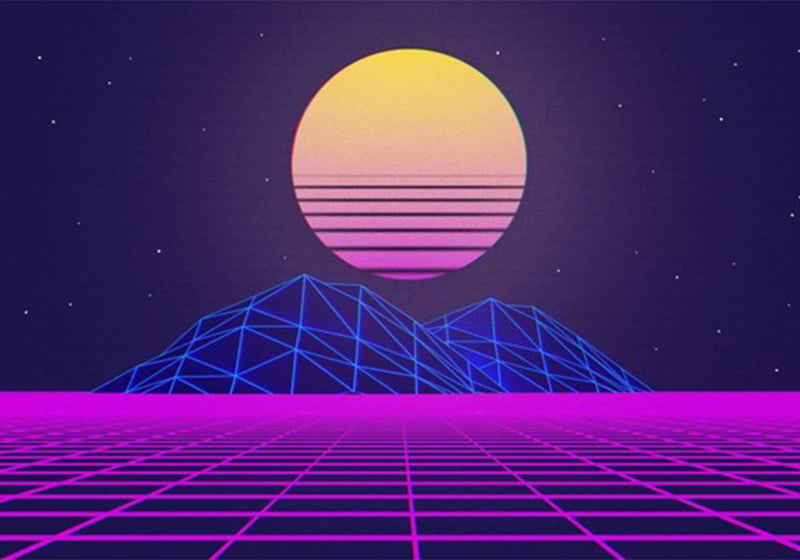Table of Contents
Casual, chaotic, eclectic. A mishmash of eighties icons, late-nineties tech, cyberpunk images, anime, glitches, 3D lettering, elevator music and synths. Ladies and gentlemen, this is vaporwave.
Born around 2010 – and pronounced dead on countless occasions since – this musical and visual genre has influenced art, filmmaking and fashion, spawning numerous memes along the way. Such has been its impact that some observers believe vaporwave will be one of the key design trends of the next few years.
Does that mean we’re going to be seeing more vapor tropes and fluorescent colours in mainstream products?
Who knows. In the meantime, read on if you want to know the answer to the following questions: What is vaporwave? What are the key characteristics of its aesthetic? And what does it have to do with the consumer society of the eighties and nineties?
This is the story of vaporwave, an ambiguous and decidedly ironic genre.
When did vaporwave emerge?
Vaporwave appeared around 2010. At first, it was mainly a subgenre of electronic music, although it had a strong visual component from the outset. But what does vaporwave mean? Some say the name is derived from “vaporware”, the term used to describe a piece of software that is announced but never actually released (a sort of tech Godot). This etymology underlines the ironic side to this genre, as well as its ambiguous relationship with turn-of-the-millennium consumer culture.
The widely acknowledged godfathers of vaporwave are two experimental musicians who released seminal albums between 2010 and 2011.
Daniel Lopatin produced the first-ever vaporwave album, Chuck Person’s Eccojams Vol. 1, which came out in 2010. Then, 2011 saw the release of Far Side Virtual by James Ferraro, another hugely influential album for the genre.

Also coming out in 2011 was Floral Shoppe, an album by American electronic music composer Ramona Andra Xavier, who released the record under the pseudonym Macintosh Plus, a nod to the revolutionary eighties computer. Some critics consider it the most representative release of the vaporwave genre, particularly the track Lisa Frank 420 / Modern Computer.

Right: if you’re curious and want to listen to a bit of classic vaporwave, here’s a list of essential tracks selected by Apple Music.
Vaporwave’s eclectic aesthetic
Fluorescent yellows and greens, eighties visuals, nineties web design, glitches, 3D models, anime: vaporwave’s aesthetic is as distinctive as it is difficult to describe.

So here’s a list of the most commonly recurring elements. Vaporwave’s references mostly come from eighties and nineties consumer culture: pixelated fonts, logos from famous brands like Nike, Adidas, Pepsi and PlayStation, clips from the Simpsons, Japanese anime and, of course, lots of computers and electronic hardware.
Even the dominant colours of the vaporwave aesthetic are somewhat nostalgic: eighties neon purples and blues, and nineties fluorescents. Here’s a fairly typical vaporwave colour palette.

These elements are often placed in alienating contexts, liminal spaces like shopping centres, empty, abandoned, and somehow unsettling. On other occasions, they’re ironically recontextualised.
Although very much a musical micro-genre and internet subculture, vaporwave has often found its way into more mainstream aesthetics. A great example is this fantastic (if you like that sort of thing) PVC backpack from Louis Vuitton.

In 2018, Nike explicitly drew inspiration from vaporwave for its line of running shoes, while Vapor95 is a fashion label dedicated to this look.

What’s behind vaporwave: anti-consumerism and irony
The fact that vaporwave has hit the mainstream might seem ironic to some.
Vaporwave emerged as a reaction to the consumer culture of the eighties and nineties, which was when the genre’s key artists grew up.
Vaporwave nostalgically draws upon consumer content from the eighties and nineties – like adverts, Adidas logos, the PlayStation and Japanese cartoons – but rips it from its original context and recasts it in floating ethereal music or unsettling abandoned spaces. In doing so, some argue, it reveals the decadent side to consumer culture.
But for others, vaporwave is, more than anything, a parody, a joke, a meme. It’s a way to mock the consumer culture and our obsessions as children of the eighties. If you’re interested in learning more, we highly recommend this mini documentary)
What do you think about the vaporwave aesthetic? Will it inspire your next design?

